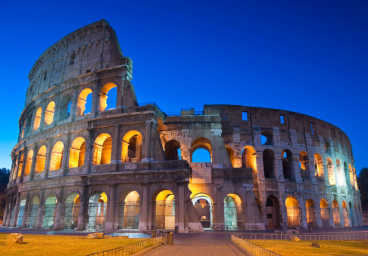Nestled in the heart of Rome, Italy, the Colosseum stands as an enduring symbol of the grandeur and architectural prowess of ancient Rome. Also known as the Flavian Amphitheatre, this iconic structure has witnessed centuries of history, from gladiatorial contests and public spectacles to the ebb and flow of empires. As one of the most recognizable landmarks in the world, the Colosseum remains a testament to the ingenuity and engineering mastery of its creators.
Historical Significance
Commissioned by Emperor Vespasian of the Flavian dynasty in AD 72 and completed in AD 80 by his successor Titus, the Colosseum was a testament to the might of the Roman Empire. Its purpose was to host public spectacles, including gladiator contests, animal hunts, executions, and mock sea battles. The Colosseum’s design and engineering innovations allowed it to accommodate tens of thousands of spectators.
Architectural Marvel
The Colosseum’s elliptical shape and grand scale make it a marvel of ancient engineering. Constructed primarily of travertine limestone and concrete, the amphitheater spans six acres and reaches a height of over 150 feet. With a seating capacity of up to 80,000 spectators, it was a monumental feat of Roman engineering and architecture.
Arena and Hypogeum: Gladiatorial Spectacles Unveiled
The central arena, where gladiators once battled for their lives, was a wooden-floored space covered with sand. Beneath the arena, the hypogeum—a network of tunnels and chambers—housed gladiators, animals, and props, providing a dramatic entrance to the arena floor through a system of elevators and trapdoors.
Triumphal Arch and Statues: Symbolic Magnificence
The Colosseum’s exterior was adorned with a series of decorative elements, including a triumphal arch dedicated to Titus and statues of gods and emperors. The arch celebrated military victories, while the statues added a touch of symbolic and religious significance to the monument.
Decline and Restoration
Over the centuries, the Colosseum faced natural disasters, fires, and the ravages of time. Despite its decline, the Colosseum retained its awe-inspiring presence. In the modern era, preservation efforts and restoration projects have sought to protect and showcase the monument’s historical and architectural significance.
Cultural Symbolism
The Colosseum has become a symbol not only of ancient Rome but also of the endurance of human achievement. It represents the intersection of entertainment, politics, and engineering in the Roman world. Today, the Colosseum stands as a powerful symbol of the eternal city and a UNESCO World Heritage Site.
Tourist Attraction and Educational Center
The Colosseum attracts millions of visitors each year who come to marvel at its monumental scale and immerse themselves in the history it represents. Guided tours and educational programs provide insights into the daily life of ancient Rome and the significance of the Colosseum in the cultural and social fabric of the empire.
Night Illumination: A Spectacular Display
As the sun sets over Rome, the Colosseum is often bathed in a warm golden glow, creating a dramatic silhouette against the night sky. Illuminated for special occasions and events, the Colosseum’s nighttime appearance adds to its allure and evokes a sense of timeless beauty.
Global Icon and Inspiration
The Colosseum’s influence extends far beyond its physical boundaries. It has inspired countless works of art, literature, and film, becoming an enduring symbol of strength, endurance, and the passage of time. The Colosseum stands not only as a monument to the past but as a testament to the enduring legacy of human achievement and innovation.



